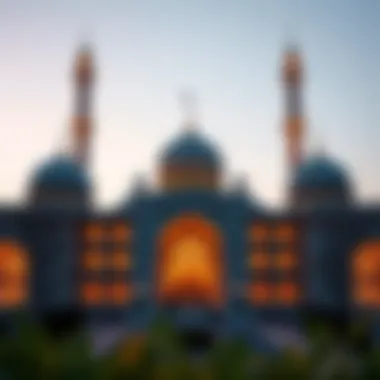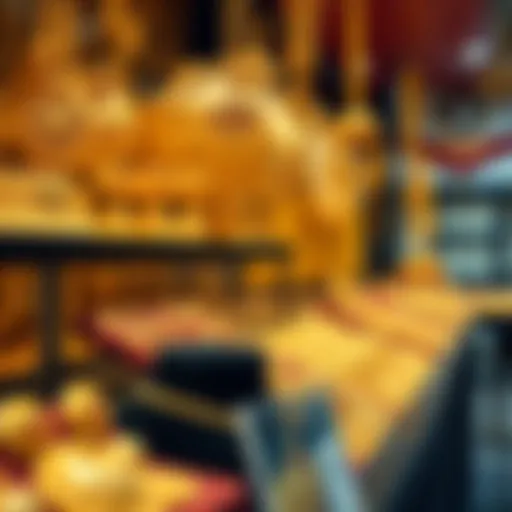Understanding Iftar Timing in 2023: A Complete Guide


Intro
Iftar, the meal with which Muslims break their fast each day during Ramadan, holds profound significance that extends beyond mere sustenance. It is a time for community, reflection, and spiritual rejuvenation. Understanding the timing of iftar, especially in 2023, delves into cultural nuances, the role of modern technology, and the rich tapestry of traditions woven through centuries.
As the sun dips below the horizon, marking the end of the fasting period, families and friends gather around feasting tables. The timing is not a mere formality but a serious observance, often calculated down to the minute based on local sunset times. In diverse cultures, the method of determining this timing can vary widely, from listening to the call of the muazzin from the local mosque to using sophisticated apps designed to give precise timings based on geographical data.
In this guide, we aim to dissect the complexities surrounding iftar timings, highlighting factors that influence its observance worldwide. We'll take a closer look at the intersection of tradition and technology, shedding light on how different communities approach this essential practice.
With myriad traditions and modern conveniences at play, understanding iftar timing presents an intriguing case study in the balancing act between heritage and innovation.
Prelims to Iftar and Its Importance
Iftar holds a significant position within the Islamic faith, marking the time when Muslims break their daily fast during Ramadan. It is not merely a meal but a moment that embodies spiritual reflection, community bonding, and cultural celebration. An exploration of iftar goes beyond its definition; it delves into the heart of the Ramadan experience, shedding light on its relevance in 2023 and beyond.
Definition of Iftar
Iftar is derived from the Arabic word "iftar," meaning "break fast." Observed daily during Ramadan, which lasts from dawn until sunset, iftar is typically initiated with the consumption of dates and water, in accordance with the Sunnah. This traditional practice serves as a reminder of simplicity and a connection to the rituals established by the Prophet Muhammad.
In contemporary settings, iftar is often a communal affair, bringing families and communities together. It's a time when people put aside their daily worries, gather at tables laden with various dishes, and express gratitude for the sustenance they have. The timing of iftar is crucial, dictated by sunset, which varies according to geographical location. Understanding when precisely to break the fast is vital for maintaining the integrity of the practice.
Cultural Significance of Iftar
The cultural importance of iftar transcends individual experiences, weaving through the fabric of communities around the globe. In various regions, traditions surrounding iftar can differ vastly, yet the core essence of community remains constant. For instance, in the Middle East, lavish spreads featuring traditional dishes can often be seen during iftar, serving as both a culinary showcase and a symbol of hospitality.
In Southeast Asia, such as in Indonesia and Malaysia, it is common to see large gatherings where people come together to share food, often highlighting local flavors and dishes unique to the region. On the other hand, in Western countries, where Muslims might be a minority, iftar can take on a different form—yet the sense of unity and community among individuals in the same faith is ever-present.
"Iftar isn’t just a meal; it’s a tapestry of tradition, a handextended in fellowship across cultures and generations."
These cultural facets and flavors enrich the experience, emphasizing that iftar is not solely about food but rather about the act of breaking bread together. As the time for iftar approaches, the anticipation can be felt in households where preparations reflect a blend of personal tradition and cultural heritage. The gathering calls for reflection, gratitude, and an appreciation for the abundance of blessings in one's life.
By comprehending iftar's definition and its cultural significance, one can begin to appreciate the depth of this sacred practice, which standing at the intersection of faith and culture, connects diverse people through shared values and communal spirit.
Understanding Ramadan
Ramadan is a sacred month in Islamic tradition, filled with profound meaning and spiritual significance. It's not just about fasting from dawn until sunset; it's a time for self-reflection, community engagement, and a heightened awareness of the less fortunate. Understanding this month within the broader Islamic faith provides deeper insights into the timing of iftar, as it's intrinsically linked to the practices observed during Ramadan.
Historical Context of Ramadan
The origins of Ramadan can be traced back to the Quran's revelation to the Prophet Muhammad in the 7th century. This month is observed in the ninth month of the Islamic lunar calendar, marking a period where Muslims worldwide participate in fasting, prayer, and reflection. The significance of Ramadan was established early in Islamic history as a time to purify the soul, cultivate empathy for the needy, and reinforce community bonds.
As societies evolved, different customs emerged. In some cultures, meals before sunset became festive occasions, evolving into social events that included elaborate dishes and communal prayers. This historical context highlights the adaptability of religious practices, ensuring they resonate across generations.
The Spiritual Journey During Ramadan
Ramadan is not simply an enactment of rituals, but rather a profound spiritual journey. Each day during this month, the fast serves as a direct reminder to Muslims about restraint, discipline, and the importance of gratitude. Fasting during Ramadan goes beyond abstaining from food and drink; it fosters a connection with the divine.
Activities such as increased prayer, reading from the Quran, and engaging in charitable actions are prevalent. This month encourages personal growth and a reevaluation of one’s life, leading many to seek forgiveness and revitalization of their faith.
"The month of Ramadan is a test for the heart and soul. It allows one to open the floodgates of positivity and self-awareness."


Furthermore, the communal component is an essential part of this spiritual journey. Families and friends gather together at iftar to break their fast, sharing their experiences and renew bonds. This social aspect, intertwined with spirituality, makes Ramadan a unique period that transcends beyond individual reflection to a community-focused awakening.
Understanding Ramadan, therefore, becomes crucial when considering iftar timings. Knowing the historical and spiritual frameworks can enhance the overall experience of this month and underscore the significance of finishing the day's fast with heartfelt intentions and shared joy.
Determining Iftar Timings
Understanding the timing of iftar is crucial for those observing the fast during Ramadan. It marks the moment when the fast is broken, and the communal aspect of breaking bread together comes into play. Getting the timing right can be a matter of tradition, spirituality, and even a bit of science. Not only does it bring a sense of unity among those fasting, but it also connects individuals to their faith and cultural practices in a deeply personal way.
The rules around when to eat can vary by location, which makes understanding how iftar timings are determined all the more important. With the right knowledge, it becomes easier to plan meals, gather with family and friends, and honor the holy month.
Calculating Sunset Times
Calculating when the sun sets is the cornerstone of determining iftar timings. Traditionally, this is when the fast is officially broken. The actual sunset can vary depending on geographical location, the time of year, and local climate conditions. In cities like Mecca, the sun sets dramatically over the horizon, while in places like Stockholm, the extended daylight can make the timing a bit trickier.
To get an accurate reading, one can make use of simple tools such as the local time and date, or rely on mobile applications devoted to Ramadan. There’s an underlying beauty here; as the sun dips below the horizon, it serves as a daily reminder of the fasting experience.
"As the sun sets, both a signal for breaking the fast and a spiritual reminder that culminates the day’s devotion."
There are online resources that can help in calculating sunset times:
- timeanddate.com
- IslamicFinder.org
These platforms allow users to input their location and receive accurate sunset times. Knowing this can remove the guesswork and helps maintain the sanctity of the ritual.
Role of Astronomical Calculations
Astronomical calculations play a vital role in determining the times for both suhoor (pre-dawn meal) and iftar (meal after sunset). These calculations often involve understanding the Earth’s rotation and its position in relation to the sun. Islamic scholars have long engaged with this, utilizing complex formulas to ensure accuracy in prayer times, including the iftar timing.
In many cases, established mosques or community centers will provide accurate timings based on their calculations for the region. While some might still rely on traditional practices, scientific methods have brought more precision. There’s no denying that modern technology has simplified what used to be a challenging task, allowing communities to come together at exactly the right moment.
Local Variations and Customs
Local customs around iftar timing can vary widely, adding rich layers to the experience. For instance, in countries like Egypt, families might gather for a long, leisurely meal after sunset, while in Indonesia, it’s common to start with light snacks, followed by heavier meals later. These practices are deeply rooted in local cultures and can influence the community’s collective experience of Ramadan.
Another aspect to consider is the use of communal loudspeakers in many mosques during Ramadan, signaling that it’s time to break the fast. In some regions, this might be a vibrant event, where people anticipate the sound as eagerly as children await gifts during holidays.
Being aware of these local variations is essential, especially for expatriates or travelers trying to navigate the obligations and traditions of Ramadan in new surroundings. The uniqueness of each location makes the experience special and memorable, reminding everyone that while the purpose of fasting is universal, the ways of breaking the fast often differ beautifully.
Iftar in Different Parts of the World
Iftar holds a unique significance across various cultures and regions, embodying shared traditions and local flavors. This section explores how the practice adapts to different environments, showcasing the rich tapestry of customs and culinary delights that characterize Iftar globally. Each culture brings its nuances, reflecting not only religious devotion but also community and togetherness during Ramadan.
Iftar Practices in the Middle East
In the Middle East, Iftar is embraced with remarkable fervor. Families gather as the sun dips below the horizon, often signaling the end of daily fasting with the call to prayer. The meal typically starts with the consumption of dates and water, honoring the tradition attributed to the Prophet Muhammad.
The dishes served during Iftar vary widely, depending on the country. In Egypt, for instance, Koshari, a hearty blend of rice, lentils, and pasta topped with a spicy tomato sauce, takes center stage. Meanwhile, Lebanon boasts dishes like Fattoush and Tabbouleh—salads that are as colorful as the celebrations themselves.
In the more traditional settings, various sweets like Baklava or Kunafa often make an appearance to satisfy the sweet tooth after breaking the fast.
Moreover, communal Iftars are organized in many cities, where people come together to share food in mosques or community centers. This aspect underscores not just the act of eating but also the significance of unity and generosity in the spirit of Ramadan.
Iftar Celebrations in Southeast Asia


Southeast Asia is home to diverse Iftar celebrations, influenced by local traditions. In countries like Indonesia and Malaysia, the Iftar meal is colorful and full of flavors, often featuring rice dishes alongside spicy curries.
In Indonesia, one might see Kolak, a dessert made of bananas cooked in coconut milk and palm sugar, served during Iftar. This sweet treat is a favorite, symbolizing the essence of the celebration.
The sense of community is palpable, as neighborhoods often host large communal meals. In Malaysia, Buka Puasa events are held, where families and friends come together to break their fast, sharing dishes that highlight the country’s rich culinary heritage.
In both Indonesia and Malaysia, Iftar is seen as a time to strengthen bonds and foster friendships, emphasizing the importance of compassion and sharing during this holy month.
Iftar Traditions in Western Countries
In Western countries, the Iftar experience often blends tradition with the local culture while maintaining its core significance. In cities like London, Toronto, and New York, the Muslim communities come together to celebrate Iftar in various ways.
Many mosques and community centers arrange large gatherings where individuals of all backgrounds are invited, marking an inclusive spirit. Traditional dishes are served alongside local favorites, ensuring a melting pot of flavors. For instance, in Toronto, you might encounter a fusion of Middle Eastern dishes with Canadian ones like poutine.
Restaurants also play a role in these celebrations, often featuring Iftar specials. In private homes, Muslims in the West often invite non-Muslim friends to join, fostering interfaith understanding. This practice not only showcases the openness of the fasting community but also serves as a bridge to share the beautiful customs and traditions of Ramadan.
"Sharing one's meal opens doorways not just to the palate but also to understanding and friendship."
Ending
Across the globe, Iftar is more than just a meal; it is a culmination of cultural practices, community bonds, and heartfelt generosity. While it retains its religious roots, the local customs infused into Iftar celebrations make it a vibrant aspect of Ramadan, showing the diversity and richness of this profound tradition.
Tools and Apps for Iftar Timing
The observance of Iftar, the meal that breaks the fast during Ramadan, is not just a routine act; it is a deeply ingrained practice that carries significant cultural and spiritual weight. In today's fast-paced world, where life can seem to zap away time, the necessity for accurate Iftar timing becomes ever more crucial. This section will discuss how modern tools and apps have emerged as vital resources. They not only aid in determining the exact time for Iftar but also enhance the overall Ramadan experience.
Mobile Applications for Timing
Mobile applications dedicated to Iftar timing have gained popularity among Muslims worldwide. These apps are developed with user-friendly features that cater to several aspects of fasting. Here are some noteworthy benefits of these applications:
- Precision Timing: Many of the top apps leverage geographical data to provide exact Iftar timings based on local sunset times. This is particularly important because sunset varies significantly from one place to another.
- Personalization Options: Users can customize settings like notifications for when it's time to break their fast. Some apps even allow users to incorporate their personal prayer times, enhancing spiritual discipline during Ramadan.
- Community Focus: Apps like Muslim Pro and My Prayer also provide community features, encouraging users to share their Iftar experiences or even invite family and friends to join in.
Moreover, smooth integration with calendar functionalities allows individuals to plan their meals appropriately. An example of an app designed precisely for this purpose is Ramadan Times, which has garnered a positive reputation due to its reliable updates and ease of use.
Web Resources for Iftar Timing
Beyond mobile applications, various web resources have become reliable platforms for determining Iftar timings. These websites compile extensive databases and tools making them accessible for users lacking smartphone capabilities. Key advantages include:
- Global Coverage: Websites can provide information for many regions across the globe, allowing expatriates or travelers to find accurate Iftar timings wherever they are.
- Informative Content: Many of these sites offer additional insights into the cultural significance of Ramadan. For instance, resources hosted on platforms such as IslamicFinder.org give not just timing but also elaborate on the religious observances associated with Iftar.
- User-Friendly Tools: With easy navigation, users can input their location information and receive real-time updates, making it simpler to stay aligned with their local fasting schedule.
One example would be timeanddate.com, which provides a host of information including sunset times and Islamic calendar dates essential for Ramadan.
With accessible timing tools, both via mobile and web, there is no doubt that technology plays a crucial role in uniting the community and enhancing the Iftar experience, even amid modern life's hustle and bustle.
Discovering and utilizing these tools not only enriches one's personal experience during Ramadan but also reinforces a sense of community amidst diverse practices worldwide.
Challenges Surrounding Iftar Timing
In any comprehensive study regarding iftar timing, navigating the hurdles that arise is essential. These challenges are multifaceted, spanning from geographical disparities to climatic conditions. As Muslims observe Ramadan, understanding these elements can significantly enhance the communal and spiritual facets of fasting.
Navigating Time Zone Differences


One prominent challenge revolves around time zones. For those traveling or residing in countries where the time difference with their home country is significant, determining the precise moment for iftar becomes a puzzle. Different regions may have varying sunset times even if the geographical distance appears minimal on the map.
- Adjustment Strategies: Muslims traveling or expatriates often rely on various apps or online tools specifically designed for calculating iftar times based on their current location. However, it is crucial to approach these platforms with caution.
- Community Coordination: In multicultural cities, it’s common for local mosques or community centers to provide announcements that synchronize the iftar timings according to the local sunset. This collective approach aids in mitigating confusion.
"The sun sets in different places at different times; unity in prayer doesn’t have to suffer but can find synergy in diversity."
Impact of Seasonal Changes
Seasonal variations add another layer of complexity to iftar timing. As Ramadan cycles through the Gregorian calendar year, the fasting month shifts, leading to drastically differing daylight hours across seasons.
- Longer Days: For instance, in countries situated nearer to the poles during summer months, fasting can extend to over sixteen hours. This added strain calls for careful planning regarding hydration and nutritional intake during the pre-dawn meal, suhoor.
- Cultural Adaptations: Some cultures have adapted their evening meals to optimize cooking and prep times around later iftar hours. Individuals may engage in communal efforts to prepare meals, enhancing both the social and nutritional components of iftar.
- Weather Influences: Additionally, in regions where Ramadan falls during harsher weather conditions - like extreme heat or cold - people may face health risks associated with fasting improperly or over-exerting themselves. Being attuned to these seasonal shifts is vital for maintaining physical well-being during this sacred month.
By acknowledging and addressing these challenges, communities can come together more effectively during Ramadan, ensuring that the essence of iftar is preserved and enriched.
Iftar and Community Building
Iftar is more than just a meal to break the fast; it serves as a cornerstone for community bonding during Ramadan. The act of coming together, sharing food, and celebrating the end of a day of fasting enriches social ties and reinforces a sense of belonging. Across various cultures, the communal aspect of iftar is emphasized as families and friends gather to partake in this cherished tradition. The spirituality intrinsic to Ramadan finds its expression not just in individual worship but in shared experiences that foster unity and compassion among participants.
Iftar as a Social Gathering
During Ramadan, iftar transforms each evening into a unique social event. Streets come alive with scents of savory dishes and sweet delights as people prepare to break bread. In many Middle Eastern cities like Cairo and Riyadh, elaborate public iftars are organized where entire communities come together. Local mosques often host these gatherings, inviting not only families but also individuals who might otherwise break their fast alone.
This tradition serves multiple purposes:
- Building Relationships: Iftar dinners are a time for reconnecting with loved ones and forging new friendships. New neighbors, colleagues, and acquaintances gather at iftar tables, sharing not just food but stories, laughter, and goodwill.
- Cultural Exchange: Different regions and cultures bring their culinary traditions to the table. From biryani in South Asia to dates filled with nuts in North Africa, these meals become a celebration of cultural diversity while promoting appreciation for each other's heritage.
Through these gatherings, individuals share dishes that are often passed down through generations, each with its own story. This practice nurtures not only the body but also the spirit of community, fostering a sense of collective identity and mutual respect.
Charitable Iftar Initiatives
The spirit of Ramadan extends beyond personal fasting, as many individuals and organizations engage in charitable initiatives centered around iftar. Engaging in acts of charity during this holy month resonates deeply with the core values of Islam, where giving and helping those in need are emphasized.
Charitable iftar initiatives can take various forms:
- Collective Iftars for the Underprivileged: Many faith-based organizations and community groups organize meals for those who cannot afford to enjoy a proper iftar. These events aim to include everyone in the joy of breaking the fast, ensuring no one feels left out.
- Food Drives and Donations: Collecting and distributing food items is a common practice during Ramadan. Supermarkets, businesses, and individuals contribute non-perishable goods to be distributed to families that struggle financially.
- Awareness Campaigns: Initiatives also focus on raising awareness about issues faced by marginalized groups. Through iftar gatherings, discussions about local challenges and solutions take center stage, encouraging community involvement.
"The act of sharing an iftar meal symbolizes unity and reinforces our duty to look after one another."
Ending
As we reach the end of this comprehensive guide on iftar timing in 2023, it is vital to underscore the multifaceted significance of iftar in Muslim societies. This ritual not only marks the end of a day of fasting but serves as a cornerstone for community building, spiritual reflection, and cultural heritage. The timing of iftar embodies more than just the practical aspect of breaking a fast; it is intertwined with the natural cycles of day and night, as well as local traditions that vary from region to region.
Reflecting on Iftar's Role
Engaging in iftar transcends the simple act of eating. It is a time for families and friends to gather, a moment to reflect on the day, and an opportunity to express gratitude. In many communities, the iftar table is a spread of diverse foods, showcasing local flavors and customs. This communal aspect allows for stronger relationships among family members and friends. When shared with those who might not have enough to eat, it epitomizes compassion and charity, which are foundational to the Ramadan experience.
Moreover, iftar provides an invitation to embrace new cultures. Across various regions, the time for iftar differs based on local sunset times, but each community adapts its own unique twist to the celebrations. For example, from the vibrant streets of Marrakech to the serene backyards in suburban America, each location brings forth its own customs that enhance the richness of this practice.
"In gathering around the iftar table, different cultures converge, reminding us of our shared humanity in ways that transcend borders."
Looking Ahead to Future Ramadans
Forecasting future Ramadans opens up a dialogue on how traditions may evolve, especially in our modern, interconnected world. With new technologies and mobile applications gaining traction, determining iftar timing is becoming increasingly efficient and accessible. These tools can significantly assist not only local communities but also expatriates or travelers navigating different time zones during Ramadan.
Furthermore, as societies become more diverse, there's a possibility of innovative culinary fusions arising during iftar gatherings. The future could see new traditions sprouting from intermingled cultures as individuals share their unique dishes, blending flavors from across the globe. It is anticipated this evolution will enrich the communal aspects of iftar, making them more inclusive and reflective of a global community. Equally important is the conversation around sustainability during Ramadan in terms of food waste and responsible sourcing, as many seek to draw connections between spirituality and environmental consciousness.
With each Ramadan, the importance of iftar continues to unfold. Embracing these changes while being rooted in the core values that underlie this significant occasion ensures the enduring legacy of iftar for future generations. Its essence remains a bastion of togetherness and reflection, critical in today’s fast-paced world.



